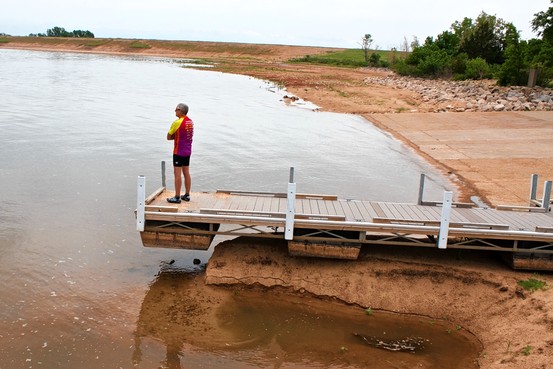In this early June Occasional, you’ll hear about Blue Baby Syndrome, nitrates in well water, nitrates in city water, fecal coliform, and Warren Buffett's coal trains. Then there are Starlight Sweaters, Total Dissolved Solids, and FEMA flood maps. More about water on Mars and more about the ongoing drought. Read advice about testing wells, raising the pH of acidic well water, and removing nitrates. Hear about the chloramine dilemma of city water plants, the EPA's gloomy assessment of the US water infrastructure, the cost of operating Des Moines' nitrate treatment equipment, and, as always, there is much, much more.
The Pure Water Occasional is a weekly email newsletter produced by Pure Water Products of Denton, Texas. We also publish the Pure Water Gazette, which posts new articles about water and water treatment daily, providing “vast piles of information in the Gazette’s tangy, irreverent style” (San Antonio Beacon). We invite you to visit PureWaterProducts.com, the most informative commercial water treatment site on the worldwide web.
If you would like to read this issue on the Pure Water Gazette’s website, please go here.
While you were hissing at Verizon for revealing your phone records, a lot of interesting things happened in the ever-changing world of water. Read on to hear about some of them.

Agribusiness Corn Farming Is Fueling the Continuing Rise in Nitrates in the Drinking Water of Farm Belt States
Ever-increasing amounts of chemical fertilizers and animal manure are being swept into rivers causing alarming increases in nitrate levels in the drinking water of farming states like Iowa, Illinois, and Minnesota. Nitrates are no longer a well-water problem. Cities like Des Moines and Cedar Rapids get their drinking water from nitrate-laden rivers and are now facing difficult and expensive removal procedures. The unsavory trade-off is that corporations get cheap corn and citizens get high-priced, low-quality drinking water.
In Iowa, nitrate levels in water have reached levels never seen before.
After a long drought, a soggy spring washed fertilizers and manure off of farms and into the rivers that provide drinking water. The elevated nitrate levels are becoming a threat to human health.
According to an AP article:
Nitrate levels have soared because drought-withered corn plants didn’t suck up all the nitrogen spread on fields last year. The drought was followed by Iowa’s wettest April in 141 years, and that rain washed unused fertilizer into rivers, the primary source of drinking water for 45 percent of the state’s population.
Nitrate in water is an issue throughout the Midwest, but Iowa is especially vulnerable because about 90 percent of the state is dedicated to agriculture. Corn requires an abundant supply of nitrogen, which must be added to the soil through the application of nitrogen fertilizer or manure.
The Environmental Protection Agency requires nitrate in drinking water be kept at less than 10 milligrams per liter. Above that level can be deadly to infants younger than 6 months because the chemical can reduce the amount of oxygen carried in their blood (Blue Baby Syndrome). Pregnant women are advised not to drink water above the EPA limit, as are adults with reduced stomach acidity. There is conflicting evidence and expert opinion regarding nitrates as a cancer causer.
Without careful management, corn in the field eventually becomes nitrates in the water.
One river in Iowa, the Racoon River upstream from Des Moines, had nitrate readings of 24 mg/L last year. The Des Moines River reported a record high 18 mg/L. Both rivers furnish drinking water for Des Moines. The city of Cedar Rapids has also experienced high levels of nitrates.
Many city water plants lack the equipment needed to reduce nitrate levels and are reduced to blending high nitrate water with water of better quality to produce an acceptable (below 10 mg/L) product. Other cities, like Des Moines, have expensive nitrate reduction equipment but prefer not to use it because of high operating cost.
Iowa and Illinois rivers typically have some of the nation’s highest nitrate levels, but other top corn states also have issues, including Indiana, Michigan, Minnesota, Ohio, Wisconsin and the eastern portions of Kansas, Nebraska, North Dakota and South Dakota.
According to the AP article cited above, nitrate levels in those states have been rising since the 1950s but leveled off in the 1980s. In the last five years, they’ve been climbing again as high corn prices have driven farmers to plant near-record corn acres. One official said: “In essence what we’re doing is subsidizing cheap food, paying for it through the high cost of cleaning up our water after it’s contaminated by fertilizer.”
And the cost indeed is high. Des Moines has now had to switch on a $4 million nitrate reduction system that costs $7,000 per day to operate. In some Minnesota cities, the price of water has risen dramatically.
The nitrate invasion is, of course, the logical result of an unsustainable agricultural system that is focused entirely on short-term profits without regard to the consequences. Farmers are being encouraged to limit fertilizer use and to leave plants in the field to lessen erosion, and many have made changes. But for most, it’s agribusiness as usual and the rivers be damned.
Source Reference: PostBulletin.com

- "A drought that is stretching into its third year is stressing drinking-water supplies from Kansas to New Mexico even as much of the nation emerges from last summer’s bone-dry conditions. Some communities in Texas are down to 180 days or less of supply, while areas of rural New Mexico have been drilling deeper wells." --Wall Street Journal.
Private Wells Should Be Tested At Least Annually
City water supplies are tested for pathogens frequently–in some cases, several times a day. Well owners, however, frequently hold the opinion that when they bought the property the well was tested and that means that it is safe for life.
In most cases the testing that is done when a home changes hands is only the most rudimentary test for coliform. Moreover, this test usually has little validity because realtors and even county officials often suggest that if the well fails, the seller of the property should “shock” treat it, then test again immediately. Passing this test offers no assurance that bacteria won’t return as soon as the effect of the massive chlorine dose wears off.
The Texas Well Owners Network recommends at least annual testing for the following:
Fecal coliform bacteria. The presence of coliform in water indicates that waste from humans or warm-blooded animals may have contaminated the water. Water contaminated with fecal coliform bacteria is more likely to have pathogens present that can cause diarrhea, cramps, nausea or other symptoms. If coliform is found, most test agencies test immediately for a prominent member of the coliform family, E coli.
Nitrates. Water with nitrates at levels of 10 parts per million is considered unsafe for human consumption. Nitrate levels above 10 ppm can disrupt the ability of blood to carry oxygen throughout the body, resulting in a condition called methemoglobinemia. Infants younger than 6 months old and young livestock are most susceptible.
Livestock feedlots are a primary source of nitrates in well water.
Total Dissolved Solids (TDS). While high TDS itself offers no immediate threat to health, an increase in salinity can indicate problems with the well. Water with high TDS levels may leave deposits and have a salty taste. Additionally, using water with high TDS for irrigation may damage soil or plants.In addition to the basic annual tests recommended by the Texas Well Owners Network, common sense should mandate more extensive testing when a home with a well is purchased and on a regular basis thereafter. Comprehensive testing at five year intervals at the very least would seem advisable.
The home owner is his own water superintendent. If he doesn’t take care of his water, no one will. A regular comprehensive water test can provide peace of mind in an age of rapid population growth, agricultural excesses, and invasive petroleum development.
Most city and county governments offer tests for coliform bacteria. Nitrates and Total Dissolved Solids can be tested with inexpensive home testing devices, and there are many excellent labs that offer comprehensive testing at a reasonable price.
Recent Water News
FEMA is putting out new flood maps. One consequence is that insurance rates for many mortgage holders have gone up. Those in newly designated high-hazard areas—which FEMA defines as having a 26% chance of flooding sometime during a 30-year mortgage period—are required by most lenders to purchase insurance through the National Flood Insurance Program. Full Story.
Some 600 workers at the Starlight Sweaters factory in Bangladesh feel ill and were hospitalized. Contaminated water at the plant is the suspected cause. Full Story.
The Sierra Club filed a complaint in federal court in Seattle saying that coal chunks and coal dust are being dumped into water around Seattle and throughout the state of Washington by trains owned by Warren Buffett, They are seeking a court order to prohibit the rail company from carrying coal in uncovered railway cars. Full Story.
Every year water purveyors, by federal law, must issue a report to their consumers telling them about their water quality. The problem is trying to understand that report. The Consumer Confidence Report, or CCR, traditionally comes with water bills, or it may be mailed separately. Starting this year, however, the U.S. Environmental Protection Agency is allowing electronic reporting for the larger water companies. Many utilities are going this way. More Information (which does not, unfortunately, tell you a lot more about how to understand the CCR).
The New York Times issued yet another report speculating that Mars had lots of water on it “more than three and a half billion years ago.” Full Story.
It is less than two months until National Garden Hose Day. Full story.
New in the Pure Water Gazette:
To Chloraminate or Not to Chloraminate: That Is the Burning Question Many City Water Departments Are Facing
Chloramine is not new. It has been used as a disinfectant in US water supplies since the 1920s. Nevertheless, when cities contemplate the change from chlorine to chloramine as their water disinfectant, there is usually controversy, sometimes heated. The change to chloramine is very important to aquarium owners, to beer and bread makers, to dialysis clinics, and to the small number of people whose skin or respiratory system seems to be especially sensitive to chloramine. There are also plumbing issues to be considered. To water treatment dealers, chloramine represents a challenge, since it is considerably more difficult to remove than chlorine. This article looks at the issue from the point of view of the city government, which faces pressure from several directions.
How Nitrates Are Removed from Drinking Water
Cities in some areas are now facing the costly task of removing nitrates from their drinking water. This is clearly an area where "point of use" treatment makes sense. Most of the 100 million gallons per day that a large city in Iowa might have to treat for nitrates is used for flushing toilets and washing cars. Cars and toilets are not affected by nitrates. Point of use drinking water systems to provide a daily gallon or two per citizen of nitrate-free drinking water is a saner way to go.
Cracking water pipes afflict Rockwell City’s waste water treatment plant
Small towns can face huge repair bills as water infrastructure ages. We’re publishing the piece below as a footnote to recent articles about the plight of water departments facing the high cost of fixing or replacing decrepit water infrastructure. The EPA estimates that the US will need $400 billion for infrastructure upgrades over the next twenty years.
Many of the Nation’s Water Treatment Facilities Are Long Overdue for Upgrade
Thousands of miles of pipes and tens of thousands of treatment plants, storage tanks and water distribution systems are sorely in need of repair, according to a recently issued EPA report.
Soda Ash
Sodium Carbonate (Na2CO3), usually known as Soda Ash, is commonly used in water treatment to increase the pH of acidic water. It has the advantage over calcite and magnesia that it does not add hardness.
Soda Ash is sensitive to temperature and works best at ambient temperatures. A typical mix ratio is 4 ounces of Soda Ash per gallon of water.
It is recommended that Soda Ash, if used with chlorine, be mixed and dissolved in the solution tank before the chlorine is added.
Soda Ash can be purchased on Pure Water Products' main website from this page. For larger quantities (and it is considerably cheaper when purchased in large amounts), please call. On the same page you can see pumps and solution tanks that are needed to treat well water with Soda Ash.
Thank you for reading, and please stay tuned next Monday for another wisdom-packed Occasional.
Places to Visit on Our Websites
Model 77: “The World’s Greatest $77 Water Filter
”Sprite Shower Filters: You’ll Sing Better!
Write to the Gazette or the Occasional: pwp@purewaterproducts.com
Please Visit
The Pure Water Gazette – now in an easier to navigate format.
![occasionalbanner300[1]](https://ymlp.com/https.php?id=purewatergazette.net/blog/wp-content/uploads/2013/04/occasionalbanner3001.gif)

![crops_306[1]](https://ymlp.com/https.php?id=purewatergazette.net/blog/wp-content/uploads/2013/06/crops_3061.jpg)
![Pig-421[1]](https://ymlp.com/https.php?id=purewatergazette.net/blog/wp-content/uploads/2012/06/Pig-42111.jpg)